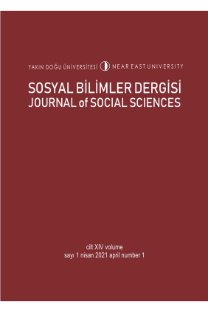YENİ KURUMSAL İKTİSATTA KURUMLARIN ROLÜ VE İŞLEVLERİNE İLİŞKİN BİR DEĞERLENDİRME
Bu çalışmanın amacı yeni kurumsal iktisadın en önemli temsilcileri olan Coase, North ve Williamson’un görüşlerinden hareketle yeni kurumsal iktisatta kurumların nasıl ele alındığını incelemektir. Bu amaçla çalışma iki kısımdan oluşmaktadır. Birinci kısımda, yeni kurumsal iktisatta kurum kavramı tartışılacak, ikinci kısımda ise yeni kurumsal iktisatçıların kurumların ortaya çıkışı, evrimi ve işlevlerine ilişkin görüşlerine değinilecektir.
AN EVALUATION ABOUT THE FUNCTIONS AND THE ROLE OF INSTITUTIONS IN NEW INSTITUONAL ECONOMICS
The purpose of this study is to analyze how the institutions are handled in new institutional economics on the basis of views of Coase, North and Williamson who are the most important representatives of new institutional economics. Having this objective in mind, the study is divided into two main parts. In the first part, how the concept of institution is evaluated in new institutional economics is discussed. In the second part, the views of new institutional economists regarding the emergence, evolution and functions of institutions is dealt with.
___
- Baş Dinar, Gülenay. (2010). “Why Institutional Economics is a Better Alternative to the Neoclassical Economics than the New Instituitonal Economics?”, International Journal of Economic Research, Vol. 7, No. 2, s. 277-286.
- Coase, Ronald H. (1937). “The Nature of The Firm”, Economica, New Series, Vol. 4, No.16, s. 386-405.
- Coase, Ronald H. (1960). “The Problem of Social Cost”, Journal of Law and Economics, Vol. 3, s. 1-41.
- Coase, Ronald H. (1998). “The New Institutional Economics”, The American Economic Review, Vol. 88, No. 2, s. 72-74.
- Hodgson, Geoffrey M. (2006). “What are Institutions”, Journal of Economic Issues, Vol. 40, No. 1, s. 1-25.
- Granovetter, Mark (1992). “Economic Institutions as Social Constructions: A Framework for Analysis”, Acta Sociologica, Vol. 35, No. 1, s. 3-11.
- Klein, Peter G. (1999). “New Institutional Economics”, in Bouckaert and De Geest Encylopedia of Law and Economics, Vol. 1, s. 456-589, Northamptom, MA: Edward Elgar.
- Mıhçı, Hakan (2000). "İktisat Yazınında Kurum ve Kurumsal Değişim Kavramları Üzerine Bir Not", Hacettepe University Journal of Economics and Administrative Sciences, Vol. 18, No. 2, s. 489-498.
- North, Douglas (1989). “Institutions, Institutional Change and Economic Growth: An Historical Introduction”, World Development, 17(9), s. 1319-1332.
- North, Douglass C. 2002 (1999). Kurumlar, Kurumsal Değişim ve Ekonomik Performans, (Çev. Gül Çağalı Güven), İstanbul: Sabancı Üniversitesi.
- Şenalp, Mehmet G. (2007). “Dünden Bugüne Kurumsal İktisat”, Kurumsal İktisat (der. Eyüp Özveren), s. 45-92, Ankara: İmge Kitabevi
- Williamson, Oliver E. (1975). Markets and Hierarchies: Analysis and Antitrost Implications, New York: Free Press.
- Williamson, Oliver E. (1979). “Transaction-Cost Economics: The Governance of Contractual Relations”. Journal of Law and Economics, Vol. 22, No. 2, s. 233-261.
- Williamson, Oliver E. (1985). The Economic Institutions of Capitalism: Firms, Markets, Relational Contracting, New York: Free Press; London: Collier Macmillan Publishers.
- Williamson, Oliver E. (1996). The Mechanisms of Governance, Oxford-NewYork: Oxford University Press.
- Williamson, Oliver E. (1998a). “TheInstitutions of Governance”, The American Economic Review, Vol. 88, No. 2, s. 75-79.
- Williamson, Oliver E. (1998b). “Transaction Cost Economics: How it Works; Where it is Headed”, De Economist, Vol. 146, No. 1, s. 23-58.
- Yılmaz, Feridun (2003). “Avrupa’da Kurumsal İktisat: G. M. Hodgson Örneği”, Kurumsal İktisat (der. Eyüp Özveren), s. 93-142, Ankara: İmge Kitabevi.
- ISSN: 1986-1303
- Yayın Aralığı: Yılda 2 Sayı
- Başlangıç: 2008
- Yayıncı: Yakın Doğu Üniversitesi
Sayıdaki Diğer Makaleler
YENİ KURUMSAL İKTİSATTA KURUMLARIN ROLÜ VE İŞLEVLERİNE İLİŞKİN BİR DEĞERLENDİRME
1960’LARDA SERMAYENİN YENİ DÜZEN ARAYIŞI: EKONOMİK VE SOSYAL ETÜDLER KONFERANS HEYETİ
MODERN ŞİİRE BİR ÖRNEK OLARAK HART CRANE’İN THE BRIDGE ADLI ÇALIŞMASI
Abubakar MUHAMMAD, Saifullahi Sani IBRAHIM
HART CRANE’S THE BRIDGE AS AN EXAMPLE OF MODERNIST POETRY
MUHAFAZAKÂR İDEOLOJİDE DEĞİŞİM TEMASI
INFORMATION AND COMMUNICATION TECHNOLOGY AND BANK PERFORMANCE IN NIGERIA: A PANEL DATA ANALYSIS
Saifullahi Sani IBRAHIM, Abubakar MUHAMMAD
